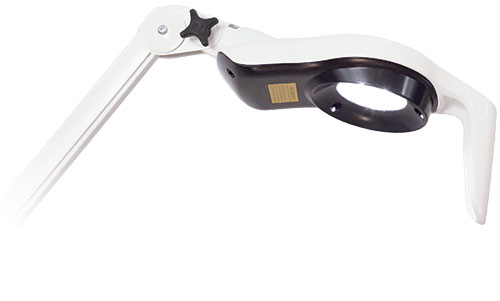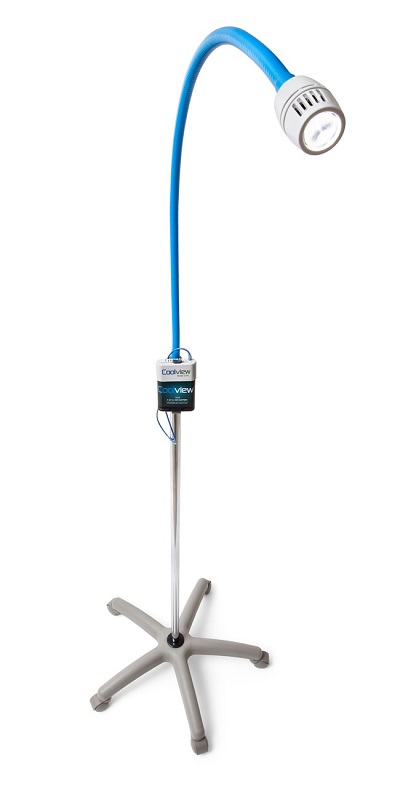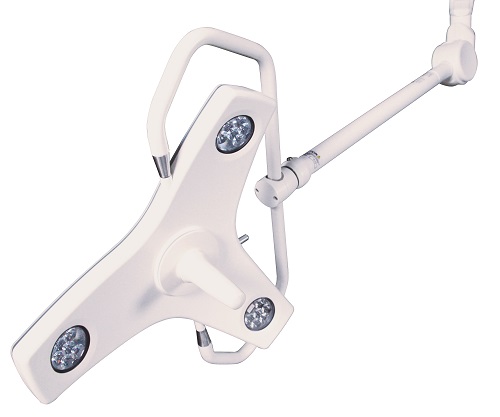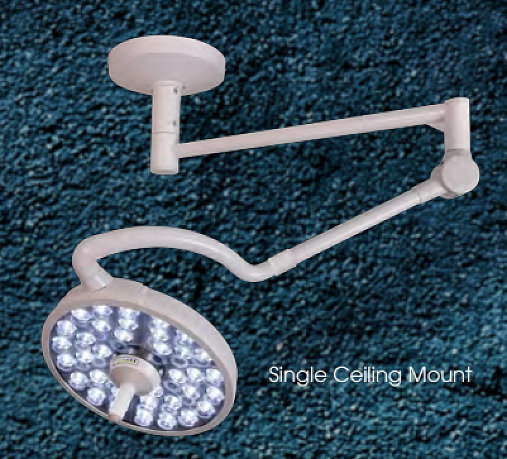 Loading... Please wait...
Loading... Please wait...Free Shipping on orders over $350
Categories
Which Medical Exam Light is Best for My Medical Office?
Posted on 01/21/2019 10:16:22
Making sure your facility has the best possible medical exam lighting is important to the medical exams, minor procedures. Optimal light quality is essential for every medical practice, though specific requirements vary across specialties, procedures and facility types. Your medical team will carry out a variety of tasks within the examination area – from physically examining patients to minor procedures – so making sure medical office lighting can quickly and easily adjust to their needs is imperative.
When
researching your medical exam light options, pay particular attention to the
following features:
5 Things to Consider Before Purchasing Medical Exam Lights
1. Mount Types
2. Portability
3. Illuminance
4. Color Rendering
5. Color Temperature
6. Bulb type / Light Source
What's the difference between surgical lights and medical lights? The importance of both types of lights is a major consideration for any medical practice, but medical exam lights are not the same as surgical lights. While a surgical light is used solely within an operating room in order to illuminate the surgical site, a medical exam light has a broader set of purposes. For example, these lights can help illuminate a local area for a visual exam, diagnostic measure, or other minor outpatient procedure. Most of the time, medical exam lighting will need to ensure that your team has an appropriate view of the skin and sclerae.
Top Features to Consider When Purchasing Medical Exam Lights
The guide below can help you narrow down and focus on the most important features to prioritize as you make decisions on how best to equip your medical facility. No matter whether you're stocking an exam room, a surgical office, a veterinary office, a dentist's office or other, your lighting can be a key factor in your team's success. In addition, making the right lighting choices can help ensure operational cost efficiencies.
1. Mount Types
Based on the needs for your practice, it’s essential to consider the best type of mounted for your staff’s medical exams and minor procedures. If health care professionals must constantly adjust lighting manually, this is distracting and can decrease the medical team's concentration. The more easily a light can be moved to a desired position and location, the better for your team – and for your patients.
You can choose from several mounting options – lights can be mounted on tabletops, ceilings and/or walls. By choosing to mount your medical exam lights, you can help ensure that they aren't a distraction and are out of the way – of both the medical professional and the patient.
Exam lights like the Burton Medical Super Exam LED light are great for general examination and can be purchased a variety of mounts and versions: Floor Stand, Ceiling Mount, table mount, wall mount. The Burton Medical Super Exam LED exam light produces very good light (35,000 lux at 1 m), has a color temperature of 4,000K, and a CRI (Color Rendering Index) of >95. It has the power and dimming switch positioned near handle and even a special coating that inhibits the growth of bacteria.

For medical team’s that portability and flexibility, consider a gooseneck exam light. A gooseneck exam light allows for easy adjustment and a wide range of flexible positioning options. This helps ensure that light adjustments are quick and easy for medical professionals so that they can spend more time focusing on patients. A great gooseneck exam light is the Coolview Portable LED Exam Light . The Coolview Portable LED Exam Light is battery powered and will operate over 4 hours on a full charge. The Coolview Portable LED Exam Light produces excellent color temperate of 6500K and it’s very bright with a its 140,000 lux (at 14 inches) output.

Some medical teams consider ceiling-mounted exam lights the easiest to work with – they typically offer more positioning options than wall-mounted versions. This configuration allows the light maximum flexibility, both horizontally and vertically, to fully illuminate the focused space. Some ceiling-mounted exam lights offer multiple arms for optimal lighting control.
While wall and ceiling-mounted lighting systems deliver a great deal of light and offer a clean and professional appearance, you should also consider their drawbacks. Because they are ultimately fixed at their base, the amount of flexibility they offer is limited – these types of lights must be mounted exactly where they're needed. If the office layout is ever redesigned, those mounted lights must be moved accordingly.
Confer with your team to discuss its particular needs related to the specific examinations and procedures typically performed within your space. For example, you'll want to ensure that a patient lying on an exam table during a procedure isn't looking directly into a bright, wall or ceiling-mounted medical office exam light.
2. Portability
Another option to consider is portable medical exam lights, which function much like their wall or ceiling-mounted counterparts, with the distinct difference of being attached to a rolling base. Using a portable stand light allows for the light source to freely move around and be deployed where appropriate. Your team can position this type of lamp exactly where it needs to be within an examining room and can even move it from room to room as need dictates. This approach allows for greater flexibility and also can save costs on initial light installments, as typically less mounting can suffice when supplementing with portable models.
While they can fill in to meet your lighting needs, portable versions do have the potential to get underfoot and in the way of your medical team, so you'll need to discuss with them and make informed choices about how many portable options your existing space can accommodate. Additionally, if a portable version is used in multiple rooms or exam spaces, you may have to put a system in place to ensure lights are available for your team when they need them – instead of misplaced in another room.
Ultimately, the most successful practices often employ a good mix of both mounted and portable medical exam lights. Doing so allows for flexibility and the tailoring of light for specific situations and procedures. Many lighting options exist that are available in dual or single ceiling-mounted, wall-mounted and portable floor versions – you can also find them with and without battery backup.
3. Illuminance
Illuminance is simply the total quantity of light falling on the surface per square meter; it is measured in "lux." Most medical lights will need to be high-intensity, but without glare or shadows that can hinder the medical professional's field of view. Overall, the illuminance of your exam light will work in tandem with the rest of your lighting, so first take the opportunity to assess what other light source options already exist within your space. What kind of overhead light is currently in place? Is natural light available? Also, pay attention to how your other lighting options cast shadows; this is something you can mitigate with the right exam lighting.
Physicians and other health care professionals perform countless procedures every day, which can cause severe eye fatigue and strain if the light isn't appropriate. If the illumination is too harsh, it can be detrimental. It's obvious that medical professionals must be able to see appropriately during any procedure, but don't be tempted to assume that brighter is always better. Bright light can cause eye fatigue and glare.
The best quality medical examination light will be designed to provide your team with properly tuned, soft illumination directed exactly where they need it. And it will do so with no shadowing and no glare, helping your team see clearly in order to interpret medical situations appropriately and give accurate diagnoses. Providing this kind of illumination allows them to work without the visual strain that often accompanies close, detailed procedures under lights that are too bright and harsh.
When making decisions about illuminance, one additional point to consider is patient comfort. Many patients enter an examination area with a sense of anxiety and dread. Using a softer level of illumination can help relax and soothe patients.
There are many exam lights available and they produce a wide range of illuminance. Illuminance is measured in lux. Most exam lights manufactured in the last few years will produce 10,000+ lux and many are in the 30,000 – 50,000 range.
If you are looking for a very bright exam light, please consider the Burton Outpatient LED Exam Light . This LED exam light is used in a all types of medical offices from hospitals, physician’s offices, and veterinary clinics and it produces 90,000 lux at 24.″

4. Color Rendering
The medical team can tell a lot about a patient's condition simply by his or her skin color. Color rendering must be true in order for such visual diagnoses to be valid. Make sure to purchase lights with accurate color rendering to reflect colors as they actually are.
LED light typically offers the truest color rendering for medical procedures. Carefully considering how the rendered color within your exam space benefits not only your medical team, but also your patients. After all, few people visit a medical exam room feeling their best, and according to some studies, patients report feeling even worse and more depressed in a medical facility than at home. Often with LED bulbs, you can use lights that more closely mimic natural light, which is not only helpful for your team but also soothing to your patients. In addition, they come in many color temperatures, so there's a range of options to fit your existing amount of natural light, along with the specific procedures performed within a space.
Most quality exam lights will have a color rendition index (CRI) from 85 – 100.
5. Color Temperature
Color Temperature is the measurement of the light source’s color relative to an ideal light source such as full sunlight (5,800 K). Color Temperature is measured in degrees Kelvin. It’s common to see many halogen exam lights with a color temperate 3,000 K – 4,000 K while many LED medical exam lights are 4,000+ K.
For more information on luminance, color rendition, and color temperature, please see our surgical lights buyer’s guide .
6. Bulb Type / Light Source
Most lights used in medical settings have historically used halogen bulbs, but these are largely being replaced by LED lights. In fact, some health care facilities have procurement policies that mandate replacing traditional halogen bulbs with their LED counterparts.
Overall, LED lights have lower maintenance costs since LED medical exam lights may last up to 30 times longer than halogen versions. Additionally, they use less electricity and will lower utility costs – in fact, some manufacturers claim that LED bulbs use up to 70 percent less energy to operate. This becomes significant when you consider the claim that energy costs compose up to 40 percent of a practice's building costs – and much of those costs are related to lighting.
LED lights allow your team to see truer skin pigmentation and overall color when examining patients. They run at a low temperature and produce very little heat. There is no worry about patients accidentally touching hot-burning bulbs or reason to fear storing combustible materials near LED bulbs. With the cooler-burning bulbs, your medical team and your patients stay more comfortable as well.
You'll also want to consider the ongoing cost of ownership – while LED bulbs are pricier upon initial purchase, their longer-lasting performance means that you won't replace them as often as their halogen counterparts. Some LED exam lights have can have a life span up to 50,000 hours–that is a significant improvement over the lifespan of halogen, metal halide, and xenon exam lights.
The Medical Illumination MI-550 LED Exam Light is an example of a great LED medical exam light that is widely used in medical facilities. It’s available in a portable floor model, wall model, and single and dual ceiling mounts. The Medical Illumination MI-550 LED Exam Light produces a bright, accurate color and it has a 50,000 hour-rated LED life. The MI-550 produces 55,000 lux at 24", 4,300° K pure white illumination, and a Color Rendering Index of 97.

Choosing the Best Medical Lights for your Facility
Procuring the best possible medical exam lights is an important task for your health care facility – it can also be time-consuming and complex. Your choice of medical exam lights affects working conditions for your team, which directly influences its ability to provide the best possible patient care. Working under poorly lit conditions can have repercussions ranging from eye strain to increased medical errors, poor team morale, and reduced productivity – or at the very worst, mistakes that lead to negative outcomes for patients.
The good news is that you have many options, and recent technological improvements can help your medical team see better than ever, and thus reduce the risk of negative patient outcomes.
For more information and additional guidance on choosing the best medical lighting and other surgical supplies for your health care facility, contact USA Medical and Surgical Supplies. Call us toll-free at 1-866-561-2380 or send us an email.



